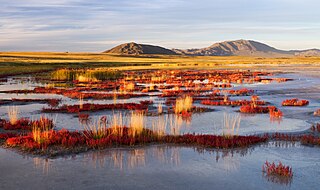
Uvs Province is one of the 21 aimags (provinces) of Mongolia. It is located in the west of the country, 1,336 kilometres or 830 miles away from the national capital Ulaanbaatar. Its capital is Ulaangom which lies 936 metres or 3,070 feet above sea level.

Ulaangom is the capital of Uvs Province in Mongolia. It is located on the slopes of the Kharkhiraa mountain, 26 kilometres (16 mi) southwest from Uvs Lake shore and 120 kilometres or 70 miles south from the Russian border.

Lake Khövsgöl is a lake in Khövsgöl Province, Mongolia. It is the largest freshwater lake in the country by volume and second largest by area after Uvs Lake. It is nicknamed the "Younger sister" of those two "sister lakes".

Uvs Lake is a highly saline lake in an endorheic basin—Uvs Nuur Basin, primarily in Mongolia with a smaller part in Russia. It is the largest lake in Mongolia by surface area, covering 3,350 km2 at 759 m above sea level. The northeastern tip of the lake is situated in the Tuva Republic of the Russian Federation. The largest settlement near the lake is Ulaangom. This shallow and very saline body of water is a remainder of a huge saline sea which covered a much larger area several thousand years ago.

Oirat is a Mongolic language spoken by the descendants of Oirat Mongols, now forming parts of Mongols in China, Kalmyks in Russia and Mongolians. Largely mutually intelligible to other core Central Mongolic languages, scholars differ as to whether they regard Oirat as a distinct language or a major dialect of the Mongolian language. Oirat-speaking areas are scattered across the far west of Mongolia, the northwest of China and Russia's Caspian coast, where its major variety is Kalmyk. In China, it is spoken mainly in Xinjiang, but also among the Deed Mongol of Qinghai and Subei County in Gansu.
Bökhmörön is a sum (district) of Uvs Province in western Mongolia.
Khovd is a sum (district) of the Uvs aimag (province) in Mongolia. It is located in the south-west of the aimag, at the border to the Bayan-Ölgii Aimag. It is situated in the Achit Lake depression, sum center is 28 km SE from the lake at the Khovd River left bank. Eastern part of the sum is situated in Kharkhiraa-Türgen mountains.
Khyargas is a sum (district) of Uvs Province in western Mongolia.

Naranbulag is a sum (district) of Uvs Province in western Mongolia.
Ölgii is a sum (district) of Uvs Province in western Mongolia.
Sagil is a sum (district) of Uvs Province in western Mongolia.

Tes is a sum (district) of Uvs Province in western Mongolia.
Türgen is a sum (district) of Uvs Province in western Mongolia.
Zavkhan is a sum (district) of Uvs Province in western Mongolia.
Züüngovi is a sum (district) of Uvs Province in western Mongolia.
Züünkhangai is a sum (district) of Uvs Province in western Mongolia. The sum is in the Khan Khökhii mountains.

The Tes River is a river in northwestern Mongolia and southern Tuva, Russia. Its spring is in Tsagaan-Uul sum in Khövsgöl. The river then flows through Zavkhan (Mongolia), Tuva (Russia), next back to Uvs (Mongolia) before entering Uvs Lake. While in Khövsgöl, there is a wooden bridge near Tsetserleg and a concrete bridge near Bayantes on the road to Kyzyl, Russia.

Uvs Lake Basin is an endorheic basin located on the territorial border of Mongolia and Tuva, a republic of the Russian Federation. The basin is part of the Central Asian Internal Drainage Basin and is named after Uvs Lake, a large saline lake situated in the western part of its drainage basin, and is one of the last remnants of the mammoth steppes. Uvs Lake is a shallow lake with an area of 3,350 km2 (1,290 sq mi). Its entire basin, which includes several smaller lakes, is 70,000 km2 (27,000 sq mi).

The Mongolia–Russia border is the international border between Mongolia and the Russian Federation. It runs from west to east between the two tripoints with China for 3,452 km (2,145 mi). The boundary is the third longest border between Russia and another country, behind the Kazakhstan–Russia border and the China–Russia border.
The Kharkhiraa River is a river in the Uvs Province of Mongolia.











